Mehndi or Henna is a paste that is bought in a cone shaped tube and is made into designs for men and women. It is also derived from the Sanskrit word mendhikā.
 T
T

 he use of mehndi and turmeric is described in the earliest Hindu Vedic ritual books. It was originally used for only women's palms and sometimes for men, but as time progressed, it is more natural for men to wear it. Haldi (staining oneself with turmeric paste) as well as mehndi are Vedic customs, intended to be a symbolic representation of the outer and the inner sun. Vedic customs are centered on the idea of "awakening the inner light." Traditional Indian designs are of representations of the sun on the palm, which, in this context, is intended to represent the hands and feet.
he use of mehndi and turmeric is described in the earliest Hindu Vedic ritual books. It was originally used for only women's palms and sometimes for men, but as time progressed, it is more natural for men to wear it. Haldi (staining oneself with turmeric paste) as well as mehndi are Vedic customs, intended to be a symbolic representation of the outer and the inner sun. Vedic customs are centered on the idea of "awakening the inner light." Traditional Indian designs are of representations of the sun on the palm, which, in this context, is intended to represent the hands and feet.
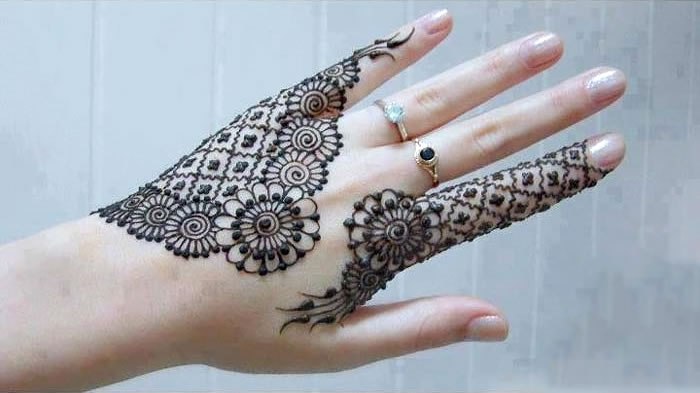

There are many variations and types in Mehndi Designs which are categorized such as Arabic Mehndi Designs,[2] Indian Mehndi Designs,[3] Pakistani Mehndi Designs. Women usually apply this all variations of Henna or Mehndi Designs patterns on their Hands and Foot.

Mehndi is the local variant of henna designs in the Indian sub-continent. Indian, Bangladeshi, Pakistani and Sri Lankan women use mehndi for festive occasions, such as weddings, religious events and traditional ceremonies.
 For over five thousand years, henna has served as a symbol of good luck, health and sensuality in the Arab world[citation needed]. The plant has been associated with positive vibes and provides a link to an ancient age full of good and bad spirits, Baraka and Jnoun. Generations of women have used a paste made primarily of dried ground henna leaves to cover their hands and feet with designs ranging from simple blobs to intricate geometric patterns designed to ward off evil, promote fertility and attract good energy.
For over five thousand years, henna has served as a symbol of good luck, health and sensuality in the Arab world[citation needed]. The plant has been associated with positive vibes and provides a link to an ancient age full of good and bad spirits, Baraka and Jnoun. Generations of women have used a paste made primarily of dried ground henna leaves to cover their hands and feet with designs ranging from simple blobs to intricate geometric patterns designed to ward off evil, promote fertility and attract good energy.
 While there is some controversy over the origins of the use of henna as a dying agent, the earliest clear evidence of henna application on the body appears in Egyptian mummies whose hair and nails were stained with the reddish brown tones of henna. Botanists believe the henna plant, Lawsonia inermis, originated in Egypt and was carried regularly to India where it was used since at least 700 AD for decorating hands and feet. Historically henna has also been used for medicinal purposes, to dye cloth and leather as well as hair, to color the manes of horses and other fur of other animals.
While there is some controversy over the origins of the use of henna as a dying agent, the earliest clear evidence of henna application on the body appears in Egyptian mummies whose hair and nails were stained with the reddish brown tones of henna. Botanists believe the henna plant, Lawsonia inermis, originated in Egypt and was carried regularly to India where it was used since at least 700 AD for decorating hands and feet. Historically henna has also been used for medicinal purposes, to dye cloth and leather as well as hair, to color the manes of horses and other fur of other animals.






Practiced mainly in India and the Arab world, mehndi or henna is the application of as a temporary form of skin decoration, popularized in the West by Indian cinema and entertainment industry, the people in Nepal, Pakistan, Bangladesh and the Maldives also use mehndi. Mehndi decorations became fashionable in the West in the late 1990s, where they are called henna tattoos.

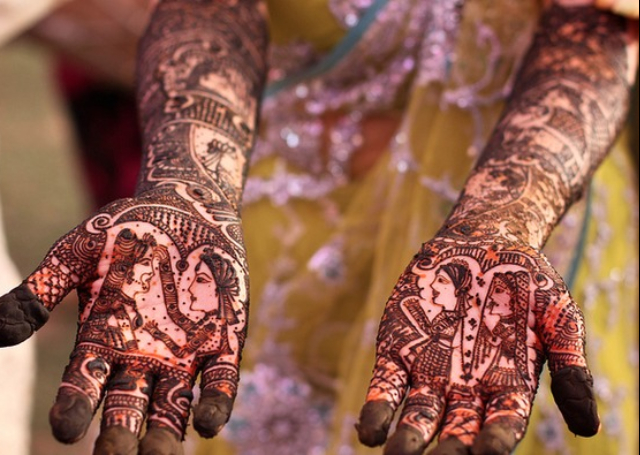


Mehndi in Indian tradition is typically applied during special Hindu weddings and Hindu festivals like Karva Chauth, Vat Purnima, Diwali, Bhai Dooj and Teej. In Hindu festivals, many women have Henna applied to their hands and feet and sometimes on the back of their shoulders too, as men have it applied on their arms, legs, back, and chest. For women, it is usually drawn on the palm, back of the hand and on feet, where the design will be clearest due to contrast with the lighter skin on these surfaces, which naturally contain less of the pigment melanin. Henna was originally used as a form of decoration mainly for Hindu brides. Muslims of Indian subcontinent also apply Mendi during their festivals like Eid-ul-Fitr and Eid-ul-Adha.


In the modern age and even due to limited supply of Indian Traditional Mehndi artists, usually people buy ready-made Henna cones, which are ready to use and make painting easy. However, in rural areas in India, women grind fresh henna leaves on grinding stones with added OIL, which though not as refined as professionally prepared henna cones, achieves much darker colors.
The term henna tattoo is figurative, because true tattoos are permanent surgical insertions of pigments into the skin, as opposed to pigments resting on the surface as is the case with mehndi.
Likely due to the desire for a "tattoo-black" appearance, many people have started adding the synthetic dye p-Phenylenediamine (PPD) to henna to give it a black colour. PPD may cause severe allergic reactions and was voted Allergen of the Year in 2006 by the American Contact Dermatitis Society. Alata (Mahur) is a flower-based dye used similarly to henna to paint the feet of the brides in some regions of India. It is still used in Bengal.

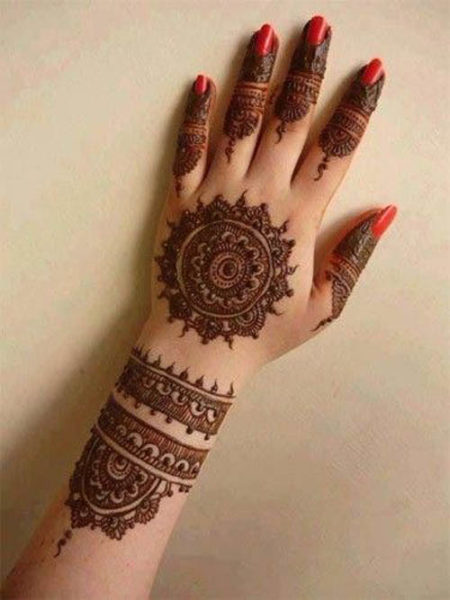

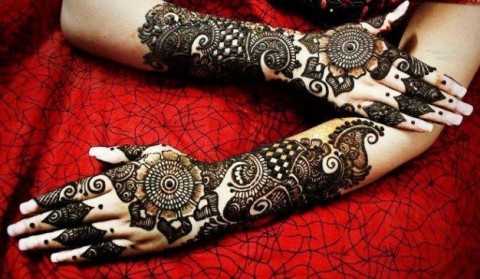
Tradition
Mehndi is a ceremonial art form which originated in ancient Subcontinent of India which is now Pakistan and India. Intricate patterns of mehndi are typically applied to brides before wedding ceremonies. The groom is also painted in some parts of India. In Rajasthan, the grooms are given designs that are often as elaborate as those for brides. In Assam, apart from marriage, it is broadly used by unmarried women during Rongali bihu, but there are no restrictions on its use by married women.
Muslims in Pakistan also started to use it as an indication of coming of age. Henna is now also used in some Gulf States, where the night before the wedding night is dedicated to decorating the bride with henna, and called "Henna night". Also, as an alternative to a 'hen party' in the Western countries, some families have "Mehndi nights", or "henna nights", similar to the ones in the Gulf States. The bride and also close friends of the bride have their hands, arms and even feet decorated with henna. In the Middle East and Africa, it is common for women to apply henna to their fingernails and toenails and to their hands.

Process
 The Mehndi celebration
The Mehndi celebration

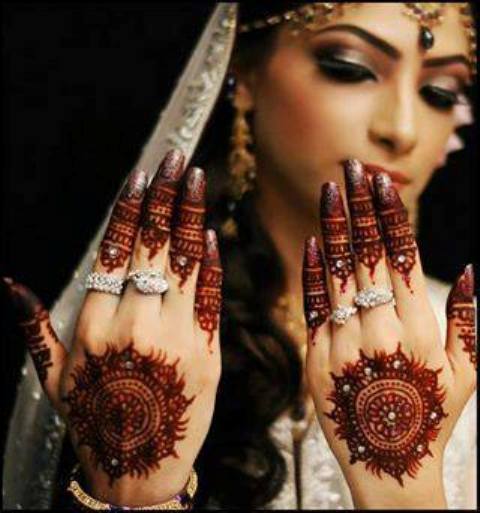 In Pakistan, the Mehndi is often one of the most important and fun filled pre-wedding ceremonies, which is celebrated mainly by the bride's family. In Bangladesh, the Mehndi ceremony has traditionally been separated into two events; one organized by the bride's family and one, by the groom's family. Mehndi ceremonies take place outside India, Pakistan and Bangladesh amongst the South Asian community and places like Birmingham in the UK are such known hotspots for lavish Mehndi celebrations. Henna was first used by Egyptians' using mud to create patters and this is where it originated from.
In Pakistan, the Mehndi is often one of the most important and fun filled pre-wedding ceremonies, which is celebrated mainly by the bride's family. In Bangladesh, the Mehndi ceremony has traditionally been separated into two events; one organized by the bride's family and one, by the groom's family. Mehndi ceremonies take place outside India, Pakistan and Bangladesh amongst the South Asian community and places like Birmingham in the UK are such known hotspots for lavish Mehndi celebrations. Henna was first used by Egyptians' using mud to create patters and this is where it originated from.




 T
T

 he use of mehndi and turmeric is described in the earliest Hindu Vedic ritual books. It was originally used for only women's palms and sometimes for men, but as time progressed, it is more natural for men to wear it. Haldi (staining oneself with turmeric paste) as well as mehndi are Vedic customs, intended to be a symbolic representation of the outer and the inner sun. Vedic customs are centered on the idea of "awakening the inner light." Traditional Indian designs are of representations of the sun on the palm, which, in this context, is intended to represent the hands and feet.
he use of mehndi and turmeric is described in the earliest Hindu Vedic ritual books. It was originally used for only women's palms and sometimes for men, but as time progressed, it is more natural for men to wear it. Haldi (staining oneself with turmeric paste) as well as mehndi are Vedic customs, intended to be a symbolic representation of the outer and the inner sun. Vedic customs are centered on the idea of "awakening the inner light." Traditional Indian designs are of representations of the sun on the palm, which, in this context, is intended to represent the hands and feet.

There are many variations and types in Mehndi Designs which are categorized such as Arabic Mehndi Designs,[2] Indian Mehndi Designs,[3] Pakistani Mehndi Designs. Women usually apply this all variations of Henna or Mehndi Designs patterns on their Hands and Foot.

Mehndi is the local variant of henna designs in the Indian sub-continent. Indian, Bangladeshi, Pakistani and Sri Lankan women use mehndi for festive occasions, such as weddings, religious events and traditional ceremonies.
 For over five thousand years, henna has served as a symbol of good luck, health and sensuality in the Arab world[citation needed]. The plant has been associated with positive vibes and provides a link to an ancient age full of good and bad spirits, Baraka and Jnoun. Generations of women have used a paste made primarily of dried ground henna leaves to cover their hands and feet with designs ranging from simple blobs to intricate geometric patterns designed to ward off evil, promote fertility and attract good energy.
For over five thousand years, henna has served as a symbol of good luck, health and sensuality in the Arab world[citation needed]. The plant has been associated with positive vibes and provides a link to an ancient age full of good and bad spirits, Baraka and Jnoun. Generations of women have used a paste made primarily of dried ground henna leaves to cover their hands and feet with designs ranging from simple blobs to intricate geometric patterns designed to ward off evil, promote fertility and attract good energy. While there is some controversy over the origins of the use of henna as a dying agent, the earliest clear evidence of henna application on the body appears in Egyptian mummies whose hair and nails were stained with the reddish brown tones of henna. Botanists believe the henna plant, Lawsonia inermis, originated in Egypt and was carried regularly to India where it was used since at least 700 AD for decorating hands and feet. Historically henna has also been used for medicinal purposes, to dye cloth and leather as well as hair, to color the manes of horses and other fur of other animals.
While there is some controversy over the origins of the use of henna as a dying agent, the earliest clear evidence of henna application on the body appears in Egyptian mummies whose hair and nails were stained with the reddish brown tones of henna. Botanists believe the henna plant, Lawsonia inermis, originated in Egypt and was carried regularly to India where it was used since at least 700 AD for decorating hands and feet. Historically henna has also been used for medicinal purposes, to dye cloth and leather as well as hair, to color the manes of horses and other fur of other animals.





Practiced mainly in India and the Arab world, mehndi or henna is the application of as a temporary form of skin decoration, popularized in the West by Indian cinema and entertainment industry, the people in Nepal, Pakistan, Bangladesh and the Maldives also use mehndi. Mehndi decorations became fashionable in the West in the late 1990s, where they are called henna tattoos.




Mehndi in Indian tradition is typically applied during special Hindu weddings and Hindu festivals like Karva Chauth, Vat Purnima, Diwali, Bhai Dooj and Teej. In Hindu festivals, many women have Henna applied to their hands and feet and sometimes on the back of their shoulders too, as men have it applied on their arms, legs, back, and chest. For women, it is usually drawn on the palm, back of the hand and on feet, where the design will be clearest due to contrast with the lighter skin on these surfaces, which naturally contain less of the pigment melanin. Henna was originally used as a form of decoration mainly for Hindu brides. Muslims of Indian subcontinent also apply Mendi during their festivals like Eid-ul-Fitr and Eid-ul-Adha.


In the modern age and even due to limited supply of Indian Traditional Mehndi artists, usually people buy ready-made Henna cones, which are ready to use and make painting easy. However, in rural areas in India, women grind fresh henna leaves on grinding stones with added OIL, which though not as refined as professionally prepared henna cones, achieves much darker colors.
The term henna tattoo is figurative, because true tattoos are permanent surgical insertions of pigments into the skin, as opposed to pigments resting on the surface as is the case with mehndi.
Likely due to the desire for a "tattoo-black" appearance, many people have started adding the synthetic dye p-Phenylenediamine (PPD) to henna to give it a black colour. PPD may cause severe allergic reactions and was voted Allergen of the Year in 2006 by the American Contact Dermatitis Society. Alata (Mahur) is a flower-based dye used similarly to henna to paint the feet of the brides in some regions of India. It is still used in Bengal.




Tradition
Mehndi is a ceremonial art form which originated in ancient Subcontinent of India which is now Pakistan and India. Intricate patterns of mehndi are typically applied to brides before wedding ceremonies. The groom is also painted in some parts of India. In Rajasthan, the grooms are given designs that are often as elaborate as those for brides. In Assam, apart from marriage, it is broadly used by unmarried women during Rongali bihu, but there are no restrictions on its use by married women.
Muslims in Pakistan also started to use it as an indication of coming of age. Henna is now also used in some Gulf States, where the night before the wedding night is dedicated to decorating the bride with henna, and called "Henna night". Also, as an alternative to a 'hen party' in the Western countries, some families have "Mehndi nights", or "henna nights", similar to the ones in the Gulf States. The bride and also close friends of the bride have their hands, arms and even feet decorated with henna. In the Middle East and Africa, it is common for women to apply henna to their fingernails and toenails and to their hands.

Process
Henna paste is usually applied on the skin using a plastic cone or a paint brush, but sometimes a small metal-tipped jacquard[disambiguation needed] bottle used for silk painting (a jac bottle) is employed. After about 15–20 minutes, the mud will dry and begin to crack, and during this time, a mixture of lemon juice and white sugar can be applied over the henna design to remoisten the henna mud so that the henna will stain darker. The painted area is then wrapped with tissue, plastic, or medical tape to lock in body heat, creating a more intense colour on the skin. The wrap (not a traditional method), is worn for 2 to 6 hours, or sometimes overnight and then removed. When first removed, the henna design is pale to dark orange in colour and gradually darkens through oxidation, over the course of 24 to 72 hours. The final color is reddish brown and can last anywhere from one to three weeks depending on the quality and type of henna paste applied, as well as where it was applied on the body (thicker skin stains darker and longer than thin skin). Moisturizing with natural OILS, such as olive, sesame seed, or coconut, will also help extend the lifetime of the stain. Skin exfoliation causes the henna tattoo to fade.
 The Mehndi celebration
The Mehndi celebration
Traditional Pakistani and Hindu Weddings in India can often be long, ritualistic, and elaborate affairs with many pre-wedding, wedding and post wedding ceremonies. Different countries and regions of a country celebrate the ceremonies in different ways according to their own marriage customs, rituals, and culture.
According to Hindu tradition, the ceremony is mainly held at the bride's house or at a banquet hall on the eve of the marriage ceremony or few days before the marriage. Generally the bride and groom attend the event together and on the occasion a professional mehndi artist or a relative applies mehndi to the bride's hands and feet. The designs are very intricate. Often hidden within the mehndi pattern the name or initials of the groom are applied. The event generally has a celebratory festival feel to it with the women dancing and singing traditional songs and the girls wearing vivid colors such as hot pink and yellow, often if the bride to be wishes to tease her future groom she will make him wear purple. The groom usually wears jutti instead of western footwear.

 In Pakistan, the Mehndi is often one of the most important and fun filled pre-wedding ceremonies, which is celebrated mainly by the bride's family. In Bangladesh, the Mehndi ceremony has traditionally been separated into two events; one organized by the bride's family and one, by the groom's family. Mehndi ceremonies take place outside India, Pakistan and Bangladesh amongst the South Asian community and places like Birmingham in the UK are such known hotspots for lavish Mehndi celebrations. Henna was first used by Egyptians' using mud to create patters and this is where it originated from.
In Pakistan, the Mehndi is often one of the most important and fun filled pre-wedding ceremonies, which is celebrated mainly by the bride's family. In Bangladesh, the Mehndi ceremony has traditionally been separated into two events; one organized by the bride's family and one, by the groom's family. Mehndi ceremonies take place outside India, Pakistan and Bangladesh amongst the South Asian community and places like Birmingham in the UK are such known hotspots for lavish Mehndi celebrations. Henna was first used by Egyptians' using mud to create patters and this is where it originated from.



No comments:
Post a Comment